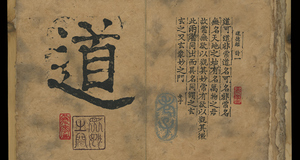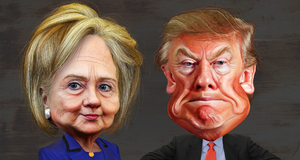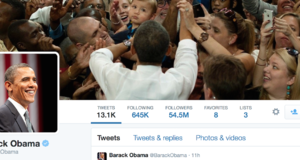Both qualitative and quantitative analysis was used while reviewing the advertisements and speeches of previous hypotheses (Moral Foundations Theory and Leadership Styles perspectives). Specifically, the methods of Moral Foundations Theory and Leadership Styles provide words and attributes to code for, which provides a qualitative analysis. The frequency of exhibits displaying these characteristics was counted, providing a quantitative perspective. When the author analyzed each exhibit, she looked for examples of rhetoric that both support and violate the moral foundations theory for liberals and conservatives.
Moral Foundations Theory is comprised of five dichotomies: harm v. care, fairness v. reciprocity, ingroup v. outgroup, authority v. respect, and purity v. sanctity. Harm v. care refers to values of “kindness, gentleness, or nuturance.” Fairness v. reciprocity can be related to ideas about equality and justice. Ingroup v. outgroup underlines principles of commitment and self-sacrifice for a particular coalition. Authority v. respect is defined as one’s ideas about leadership and followership, including respect for traditions. Lastly, sanctity v. purity is shaped by obedience, religious values, and morality. The Moral Foundation Theory was chosen for its clarity in qualitatively analyzing an abstract topic, political attitudes.
Table 1: Moral Foundations and Coded Words
|
Dichotomy
|
Possible Words
|
|
Harm v. Care
|
Recovery; compassion; neighbor; children; friend; suffering; pain; harm; safe; hurt; exploited
|
|
Fairness v. Reciprocity
|
Opportunity; bipartisan; bipartisanship; compromise; everyone; reform; equality; fair; justice
|
|
Ingroup v. Outgroup
|
Different; difference; together; community; mission; unconventional; loyal; Washington D.C. v. NJ comparisons
|
|
Authority v. Respect
|
Commitment; leadership; honored; references to other national or state leaders; respect; obey; tradition; serve
|
|
Sanctity v. Purity
|
Integrity; honest; mess; corrupt; prevention; fraud; ethical; clean (in reference to record, morals)
|
This study also analyzed the application of these moral foundations within Cameron’s Five Leadership Models because when studying leadership, Christie’s long-term political agenda should be evaluated. To determine whether Governor Christie’s moral foundations and leadership style have changed between his first and second gubernatorial election, the exhibits were coded for the moral foundation dichotomies using the word list below.
The specific words were a combination of phrases or in the case of leadership styles, attributes, in the original studies, in addition to the researcher’s original contributions. The five leadership styles presented by Cameron and Green—the Edgy Catalyzer, the Visionary Motivator, the Measured Connector, the Tenacious Implementer, and the Thoughtful Architect were also used to analyze Christie’s campaign exhibits. The leadership models were chosen because the method extended concepts of Moral Foundations Theory, but the Leaderships Styles are apolitical. A Thoughtful Architect could be a liberal, conservative, or independent; leadership characteristics are not conducive to political ideology.
The two significant leadership styles for this study were the Edgy Catalyzer and Visionary Motivator. The Edgy Catalyzer is a leader who asks the difficult, yet essential questions and creates discomfort and unease when conditions are not improved. Edgy Catalyzers are further described as not being intimidated by politics, but respecting the system’s history and power. The Visionary Motivator leadership model works to energize and engage people, but also has strong purpose, influence, and dynamism. These kinds of leaders focus on applying an organization’s resources and talents to develop a sense of potential. For more information on the three additional leadership styles and a summary of each model’s attributes, consult Table 2.
To relate the exhibits to these methods, the author counted the number of times Christie’s advertisements and speeches related to these criterions and definitions. Each dichotomy or leadership style was a category and Christie’s words, actions, and appeals were sorted to determine his emphasized moral foundations and adopted leadership styles.
Table 2: Leadership Styles
|
Leadership Style
|
Definition and Characteristics
|
|
Edgy Catalyzer
|
Focuses on and enjoys discomfort; asks the difficult questions; spots dysfunction; troubleshooter; respects power; tackles difficult topics; confrontational; cares about “getting things right”; argumentative; robust.
|
|
Visionary Motivator
|
Articulates a compelling view of future; connects with and energizes people easily; wants to focus on organization’s strengths; uses emotionally charged language; good for low morale or complex situations; upbeat.
|
|
Measured Connector
|
Establishes a few ground rules; goal is “focused reassurance;” connects different agendas and strives for common purpose; slowly creates trust; influences in an unhurried way; well respected; not interested in power politics.
|
|
Tenacious Implementer
|
Driving force in projects; forward-thinking; uses persuasive logic; works on task-related progress; has continuous and targeted communication; has very high integrity; constantly seeks to make things better.
|
|
Thoughtful Architect
|
Designs plan or strategy; may appear introverted; values depth in ideas; respects competence and expertise; very passionate; focused on long-term; sometimes struggles to favor people over concepts; reflective
|
In their studies, Cameron and Green found that while leaders are capable of all five models, individuals have a “default mode” Understanding the concept of “default mode” is critical in analyzing how Christie’s leadership styles evolved as a result of Hurricane Sandy, a primary focus in this study.
Table 3: Findings
|
2009 Coverage
|
2013 Coverage
|
|
H/C: 33%
|
EC: 100%
|
H/C: 100%
|
EC: 18%
|
|
F/R: 66%
|
VM: 0%
|
F/R: 58%
|
VM: 100%
|
|
I/O: 33%
|
MC: 33%
|
I/O: 50%
|
MC: 17%
|
|
A/R: 66%
|
TI: 66%
|
A/R: 33%
|
TI: 50%
|
|
P/S: 66%
|
TA: 0%
|
P/S: 17%
|
TA: 25%
|
|
H/C: 40%
|
EC: 80%
|
H/C: 83%
|
EC: 8%
|
|
F/R: 40%
|
VM: 20%
|
F/R: 42%
|
VM: 75%
|
|
I/O: 40%
|
MC: 0%
|
I/O: 33%
|
MC: 42%
|
|
A/R: 40%
|
TI: 60%
|
A/R: 17%
|
TI: 17%
|
|
P/S: 40%
|
TA: 20%
|
P/S: 8%
|
TA: 17%
|
According to the data, Chris Christie did shift his moral foundations and leadership style, largely from Hurricane Sandy, from 2009 to 2013. As previous studies predicted, Christie’s first gubernatorial campaign strategy reflected typical conservative moral foundations in his commercials and speeches. His appeals to the five moral foundations were equally distributed among the five dichotomies.
Coding for Cameron and Green’s Leadership Styles clearly demonstrated that the Edgy Catalyzer was Christie’s default role in 2009. One hundred percent of both campaign commercials and speeches were sorted under this style. Christie’s commercials were quantitatively based, focused presented facts and statistics, and were direct and frank.
Findings show that Christie also increased his appeals in the harm v. care dichotomy during the 2013 campaign, in television ads from 33 to 100 percent and in speeches from 40 to 83 percent. Christie also fully embraced the Visionary Motivator leadership model in 2012. In one of his television spots, a voiceover describes his leadership after Sandy: “When tragedy struck, he was there, every step of the way.”
The researcher found Moral Foundations Theory and Leadership Models related when examining how Christie uses the former to bolster his latter position. This point can be primarily seen when looking at Christie’s appeals to ingroup v. outgroup. A Visionary Motivator already has established support and credibility; Christie strategically used the characteristics of ingroup v. outgroup in his speeches to demonstrate how he is a Motivator to his audience.
In a speech with his 3rd grade teacher present, Christie charismatically explained that voters, “can’t disappoint her,” which creates an ingroup of people who support strong public schools, teachers, and Christie, and those who do not. Such appeals show that with growing numbers of support and popularity, Christie is moving toward a Visionary Motivator role as he emerges as a national leader.Continued on Next Page »
“2009 New Jersey Gubernatorial General Election: Christopher Christie (R) v. Governor Jon Corzine (D)” 2009. http://www.pollster.com/polls/nj/09-nj-gov-ge-cvc.php?nr=1 (November 1, 2009).
Bucci, Steven; Inserra, David; Lesser, Jonathan; Mayer, Matt; Slattery, Brian; Spencer, Jack; Tubb, Katie 2012. “After Hurricane Sandy: Time to Learn and Implement the Lessons in Preparedness, Response, and Resilience.” (October) http://www.heritage.org/research/reports/2013/10/after-hurricane-sandy-time-to-learn-and-implement-the-lessons (November 11, 2013).
Burling, W.; Hyle, A (1997). “Disaster Preparedness Planning” Disaster Prevention and Management 6(4): 234-244.
Cameron, Esther; Green, Mike. (2008). Making Sense of Leadership: Exploring the Five Key Roles Used by Effective Leaders. Philadelphia, PA: Kogan Page Press.
Cavaliere, Valerie. (2014, April 9). New Jersey voters see Christie’s internal bridge review as ‘whitewash’ poll. Reuters. Retrieved July 13, 2014, from http://www.reuters.com/article/2014/04/09/us-usa-politics-christie-poll
Chris Christie’s Lane Shift: From Sarcasm to Outrage. (n.d.). New Jersey News. Retrieved July 13, 2014, from http://www.wnyc.org/story/3-stages-chris-christies/crisis-management/
Ferman, Barbara. 1985. Governing the Ungovernable: Political Skill, Leadership, and the Modern Mayor. Philadelphia: Temple University Press.
Geraghty,Jim.Christie: “I am outraged and deeply saddened…I was misled.’ (n.d.). National Review Online. Retrieved July 13, 2014, from http://www.nationalreview.com/campaign-spot
Grafton, C; Permaloff, A. (2008). Liberal-conservative Conflict and Consensus in Policy Making.” The Social Science Journal 45, no. 4 (2008): 580-593.
Graham, Jesse; Haidt, Jonathan; Nosek, Brian. (2009). “Liberals and Conservatives Rely on Different Sets of Moral Foundations.” Journal of Personality and Social Psychology 96(5): 1029-46.
Henderson, Nia-Malika; O’Keefe, Ed. 2013. “Republicans Slam Boehner for Delay on Hurricane Sandy Relief Measure.” Washington Post. Jan. 2 http://articles.washingtonpost.com/2013-01-02/politics/36211763_1_cliff-vote-toxic-internal-politics-boehner-four-times (Accessed December 2nd, 2013).
Letter from Wildstein’s Lawyer on Lane Closings. (2014, January 31). The New York Times. Retrieved July 13, 2014, from http://www.nytimes.com/interactive/2014/02/01/nyregion/bridge-letter
Littlefield, R; Quenette, A. (2007). “Crisis Leadership and Hurricane Katrina: The Portrayal of Authority By the Media in Natural Disasters.” Journal of Applied Communication Research 35 (1): 26-47.
Margolin, Josh. 2008. “U.S. Attorney Christopher Christie To Step Down.” The Jersey Sting Oct. 17 http://www.nj.com/news/index.ssf/2008/11/us_attorney_christopher_christ (Accessed November 11th, 2013).
“New Jersey Governor” 2013. http://www.nytimes.com/projects/elections/2013/general/new- jersey/map (November 6 2013). Rispoli, Michael. 2009. “Gov. Corzine, Chris Christie Trade Barbs About Lobbying Histories.” The Star-Ledger Aug. 25 http://www.nj.com/news/index.ssf/2009/08/gov_corzine_chris_christie_tra.html (Accessed December 2nd, 2013).
Steinberg, Arnold. 1976. The Political Campaign Handbook. Lexington, MA ; D.C. Heath Press.
UPDATE: 6-NJ governor’s internal investigation clears him in ‘Bridgegate’. (2014, March 27). Reuters. Retrieved July 13, 2014, from http://www.reuters.com/article/2014/03/27/usa-politics/christie
Walshe, Shushannah. (2014, February 3). Chris Christie Says He ‘Unequivocally’ Had No Knowledge of Lane Closure. ABC News. Retrieved July 13, 2014, from http://abcnews.go.com/blogs/politics/2014/02/chris-christie-says-he-unequivocally-had-no-knowledge-of-lane-closure
Velez, Yamil; Martin, David. 2013. “Sandy the Rainmaker: The Electoral Impact of a Super Storm.” Political Science and Politics (April): 313-23
http://journals.cambridge.org/action/displayAbstract?fromPage=online&aid=8874452 (November 11, 2013).
Zernike, Kate. (2014, January 8). Christie Faces Scandal on Traffic Jam Aides Ordered. The New York Times. Retrieved July 13, 2014, from http://www.nytimes.com/2014/01/09/nyregion/christie-aid-tied-to-bridge-lane-closings.html.
List of Exhibits
2009
- Chris Christie Television Ad—“Corruption”
- Chris Christie for Governor 2009 Ad “A Leader”
- Chris Christie Television Ad “Leadership”
- Christie Launches Campaign Speech
- Chris Christie Campaigns in Woodland Park Speech
- Catching Up With Chris Christie on the Campaign Trail Speech
- New Jersey Gubernatorial Debate (10/01/09)
- Christie Campaigns in Morristown Speech
- Chris Christie Victory Speech (11/03/09)
2013
- “Leo” Christie for Governor Ad
- “Frank” Christie for Governor Ad
- Chris Christie: Right Direction TV Ad
- Shaq Endorses Republican Chris Christie TV Ad
- “The Difference” TV Ad
- “Courageous Leadership” TV Ad
- “Bipartisan” TV Ad
- “Compassion” TV Ad
- “Un Mejor Futuro, Mas Brilliante” TV Ad
- “They Said” TV Ad
- “Meet Barbara Buono” TV Ad
- “Governor Christie: Real Leadership for State” TV Ad
- “Getting the Job Done” TV Ad
- Both Parties Could Use a Seminar Speech
- Don’t Disappoint My 3rd Grade Teacher Speech
- I’m Honored to Stand with These Men and Women Speech
- It’s Been An Incredible Honor to Be Your Governor Speech
- Put People Ahead of the Party Speech
- This is a Historic Day Speech
- This Isn’t a Job Anymore; It’s a Mission Speech
- “I Love You, New Jersey” Victory Speech
- 2013 New Jersey Gubernatorial Debate
Endnotes
1.) Gov. Corzine, Chris Christie trade barbs about lobbying histories (NJ.com). Retrieved July 6th, 2014 from http://www.nj.com/news/index.ssf/2009/08/gov_corzine_chris_christie_tra.html
2.) NJ.com. (n.d.)—New Jersey Local News. Retrieved July 6th, 2014, from http://www.nj.com/news/index.ssf/2008/11/us_attorney_christopher_christ
3.) Pollster.com. (n.d.).—Political Surveys and Election Polls, Trends, Charts and Analysis. Retrieved July 6th, 2014 from http://www.pollster.com/polls/nj/09-nj
4.) Christie, Republicans slam Boehner for delay on Hurricane Sandy relief measure. (n.d.). Washington Post. Retrieved July 6th, 2014, from http://articles.washingtonpost.com/2013-01-02/politics/36211763_1_cliff-vote-toxic-internal-politics-boehner-four-times
5.) Bucci, Steven; Inserra, David; Lesser, Jonathan; Mayer, Matt; Slattery, Brian; Spencer, Jack; Tubb, Katie 2012. “After Hurricane Sandy: Time to Learn and Implement the Lessons in Preparedness, Response, and Resilience.” 12-15 (October) http://www.heritage.org/research/reports/2013/10/after-hurricane-sandy-time-to-learn-and-implement-the-lessons
6.) “New Jersey Governor” 2013. http://www.nytimes.com/projects/elections/2013/general/new- jersey/map. Retrieved November 6 2013.
7.) Steinberg, Arnold. 1976. The Political Campaign Handbook. Lexington, MA ; D.C. Heath Press. 42.
8.) Littlefield, R; Quenette, A. (2007). “Crisis Leadership and Hurricane Katrina: The Portrayal of Authority By the Media in Natural Disasters.” Journal of Applied Communication Research 35 (1): 42-45.
[9] Velez, Yamil; Martin, David. 2013. “Sandy the Rainmaker: The Electoral Impact of a Super Storm.” Political Science and Politics (April): 316-320.
http://journals.cambridge.org/action/displayAbstract?fromPage=online&aid=8874452. Accessed on November 11, 2013.
10.) Ferman, Barbara. 1985. Governing the Ungovernable: Political Skill, Leadership, and the Modern Mayor. Philadelphia: Temple University Press. 73-78.
11.) Ferman, Barbara. 1985. Governing the Ungovernable: Political Skill, Leadership, and the Modern Mayor. Philadelphia: Temple University Press. 130-135.
12.) Burling, W. Hyle, A (1997). “Disaster Preparedness Planning” Disaster Prevention and Management 6(4): 240.
13.) Bucci, Steven; Inserra, David; Lesser, Jonathan; Mayer, Matt; Slattery, Brian; Spencer, Jack; Tubb, Katie 2012. “After Hurricane Sandy: Time to Learn and Implement the Lessons in Preparedness, Response, and Resilience.” 17. (October) http://www.heritage.org/research/reports/2013/10/after-hurricane-sandy-time-to-learn-and-implement-the-lessons (November 11, 2013).
14.) Grafton, C; Permaloff, A. (2008). Liberal-conservative Conflict and Consensus in Policy Making.” The Social Science Journal 45, no. 4 (2008): 585-588.
15.) Graham, Jesse; Haidt, Jonathan; Nosek, Brian. (2009). “Liberals and Conservatives Rely on Different Sets of Moral Foundations.” Journal of Personality and Social Psychology 96(5): 1030.
16.) Cameron, Esther; Green, Mike. (2008). Making Sense of Leadership: Exploring the Five Key Roles Used by Effective Leaders. Philadelphia, PA: Kogan Page Press. 11-17.
17.) Cameron, Esther; Green, Mike. (2008). Making Sense of Leadership: Exploring the Five Key Roles Used by Effective Leaders. Philadelphia, PA: Kogan Page Press. 36-40.
18.) Cameron, Esther; Green, Mike. (2008). Making Sense of Leadership: Exploring the Five Key Roles Used by Effective Leaders. Philadelphia, PA: Kogan Page Press. 20.
19.) Graham, Jesse; Haidt, Jonathan; Nosek, Brian. (2009). “Liberals and Conservatives Rely on Different Sets of Moral Foundations.” Journal of Personality and Social Psychology 96(5): 1040.
20.) Cameron, Esther; Green, Mike. (2008). Making Sense of Leadership: Exploring the Five Key Roles Used by Effective Leaders. Philadelphia, PA: Kogan Page Press. 40.
21.) TV Ad, “The Difference,” 2013
22.) “Don’t Disappoint My 3rd Grade Teacher” Speech, 2013
23.) “Compassion” TV Ad, 2013
24.) “They Said” TV Ad, 2013
25.) Put People Ahead of the Party Speech, 2014
26.) Cameron, Esther; Green, Mike. (2008). Making Sense of Leadership: Exploring the Five Key Roles Used by Effective Leaders. Philadelphia, PA: Kogan Page Press. 108-112.
27.) Cameron, Esther; Green, Mike. (2008). Making Sense of Leadership: Exploring the Five Key Roles Used by Effective Leaders. Philadelphia, PA: Kogan Page Press. 40.
28.) Ferman, Barbara. 1985. Governing the Ungovernable: Political Skill, Leadership, and the Modern Mayor. Philadelphia: Temple University Press. 78.
29.) Cameron, Esther; Green, Mike. (2008). Making Sense of Leadership: Exploring the Five Key Roles Used by Effective Leaders. Philadelphia, PA: Kogan Page Press. 51.
30.) Cameron, Esther; Green, Mike. (2008). Making Sense of Leadership: Exploring the Five Key Roles Used by Effective Leaders. Philadelphia, PA: Kogan Page Press. 113.
31.) Cameron, Esther; Green, Mike. (2008). Making Sense of Leadership: Exploring the Five Key Roles Used by Effective Leaders. Philadelphia, PA: Kogan Page Press. 118.
32.) Zernike, Kate. (2014, January 8). Christie Faces Scandal on Traffic Jam Aides Ordered. The New York Times. Retrieved July 13, 2014, from http://www.nyimes.com/2014/01/09/nyregion/christe-aide
33.) Chris Christie’s Lane Shift: From Sarcasm to Outrage. (n.d.). New Jersey News. Retrieved July 13, 2014, from http://www.wync.org/story/3-stages-chris-christies
34.) Walshe, Shushannah. (2014, February 3). Christie Says He ‘Unequivocally’ Had No Knowledge of Lane Closure. ABC News. Retrieved July 13, 2014 from http:// abcnews.go.com/blogs/politics/2014/02/chris-christie
35.) Letter from Wildstein’s Layer on Lane Closings. (2014. January 31). The New York Times. Retrieved July 13, 2014, from http://www.nytimes.com/interactive/2014/02/01/nyregion/bridge-letter
36.) Zernike, Kate. (2014, January 8). Christie Faces Scandal on Traffic Jam Aides Ordered. The New York Times. Retrieved July 13, 2014, from http://www.nyimes.com/2014/01/09/nyregion/christe-aide
37.) UPDATE 6-NJ governor’s internal investigation clears him in ‘Bridgegate’. (2014, March 27). Reuters. Retrieved July 13, 2014, from http://www.reuters.com/article/2014/03/27/usa-politics
38.) Jim Geraghty-Christie: “I am outraged and deeply saddened…I was misled.’ (n.d.). National Review Online. Retried July 13, 2014, from http://www.nationalreview.com/campaign-spot
39.) Cavaliere, Valerie. (2014, April 9). New Jersey voters see Christie’s internal bridge review as ‘whitewash’; poll. Reuters. Retrieved July 13, 2014, from http://www.reuters.com/article/2014



















